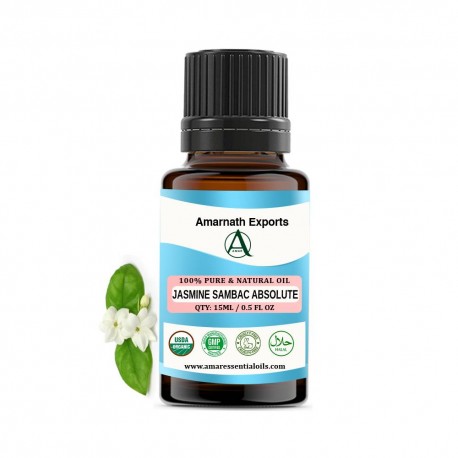No products
Product successfully added to your shopping cart
There are 0 items in your cart. There is 1 item in your cart.
Jasmine Sambac Absolute
New
Himalayans have gifted us yet another exquisite and distinctive flower, known as Jasminum Sambac. This delicate white blossom is widely cultivated worldwide, adapting to various environments to showcase its stunning flowers and heavenly scent. Whether as a shrub or a vine, it can reach heights of up to 3 meter. Belonging to the Oleaceae family, it was also introduced to Europe in the 18th century.
843 Items
More info
Buy Jasmine Sambac Absolute | Jasminum Sambac
Jasmine Sambac, also known as Arabian Jasmine or Sampaguita, traces its roots back to the tropical regions of Southeast Asia, particularly India and Myanmar. Renowned for its exquisite fragrance, this flowering plant has been cultivated for centuries, revered for both its ornamental beauty and aromatic properties.
The cultivation of Jasmine Sambac requires meticulous care and attention to detail. Thriving in warm, humid climates with well-drained soil, these fragrant blossoms flourish under the nurturing rays of the sun. Cultivators often employ traditional methods of handpicking the delicate flowers at dawn, when their fragrance is most potent, ensuring the preservation of their aromatic essence.
Extraction Process
The extraction of Jasmine Sambac Absolute is a labor-intensive process that demands precision and expertise. The delicate petals are carefully harvested and subjected to a meticulous extraction method known as enfleurage or solvent extraction. This process involves immersing the petals in a solvent, such as hexane or ethanol, to extract the aromatic compounds, resulting in a highly concentrated absolute.
Once the extraction is complete, the solvent is carefully removed through a process of evaporation, leaving behind a pure and potent essence that captures the essence of Jasmine Sambac in its truest form. The resulting absolute exudes a rich, floral aroma with subtle hints of sweetness and warmth, making it a prized ingredient in perfumery and aromatherapy.
The hue of this essential oil ranges from orangish to magenta-brown, presenting as a thick liquid with a lingering aroma characterized by its profound floral, garden-fresh, and opulent scent. Jasmine cultivated in colder regions tends to exude a more delicate and smooth fragrance, whereas flowers grown in lower altitudes emit deeper and more intense notes. It's a scent that defies description and must be experienced to be truly understood. While it can be blended harmoniously with other oils, its complexity shines best when used solo.
Aromatic Profile
Jasmine Sambac Absolute is revered for its complex and enchanting fragrance profile, characterized by its sweet, floral aroma with nuanced undertones of jasmine, honey, and exotic spices. The scent is both sensual and uplifting, evoking feelings of romance, elegance, and femininity.
In addition to its captivating aroma, Jasmine Sambac Absolute boasts a myriad of therapeutic properties, making it a versatile ingredient in natural skincare and wellness products. Rich in antioxidants and anti-inflammatory compounds, this botanical essence nourishes the skin, soothes the senses, and promotes relaxation and emotional well-being.
Applications in Perfumery
In the world of perfumery, Jasmine Sambac Absolute holds a revered status as a prized ingredient in luxury fragrances and perfumes. Its rich, floral aroma adds depth, complexity, and sensuality to a wide range of olfactory compositions, from delicate floral bouquets to opulent oriental blends.
Perfumers often blend Jasmine Sambac Absolute with other aromatic ingredients such as rose, neroli, and sandalwood to create harmonious and captivating fragrances that linger on the skin and leave a lasting impression. Whether used as a standalone note or as part of a sophisticated fragrance accord, Jasmine Sambac Absolute adds an element of timeless elegance and allure to any perfume creation.
Holistic Wellness and Aromatherapy
Beyond its olfactory allure, Jasmine Sambac Absolute possesses profound therapeutic properties that have been cherished for centuries in traditional medicine and aromatherapy. The aroma of Jasmine Sambac is believed to have calming and aphrodisiac effects, promoting relaxation, stress relief, and emotional balance.
In aromatherapy, Jasmine Sambac Absolute is often used to alleviate anxiety, depression, and insomnia, fostering a sense of calm and tranquility. Whether diffused in the air, added to bath oils, or blended into massage oils, the aroma of Jasmine Sambac envelops the senses, transporting the mind and body to a state of blissful serenity.
Aroma and Composition of Jasmine Sambac Absolute
Jasmine Sambac Absolute is characterized by its rich, floral scent with sweet undertones. It contains various chemical compounds such as benzyl acetate, benzyl alcohol, and indole, which contribute to its unique aroma and therapeutic properties.
Benefits and Uses of Jasmine Sambac Absolute
Skincare
Jasmine Sambac Absolute is prized in skincare for its moisturizing and rejuvenating properties. It helps to hydrate the skin, reduce the appearance of scars and stretch marks, and promote a youthful complexion.
Aromatherapy
In aromatherapy, Jasmine Sambac Absolute is used to promote relaxation, reduce stress, and uplift the mood. Its soothing aroma has a calming effect on the mind and body, making it ideal for relieving anxiety and promoting sleep.
Perfumery
Jasmine Sambac Absolute is a coveted ingredient in perfumery for its intense floral fragrance. It is often used as a base note in perfumes, adding depth and complexity to the scent.
Reviews
No customer comments for the moment.









